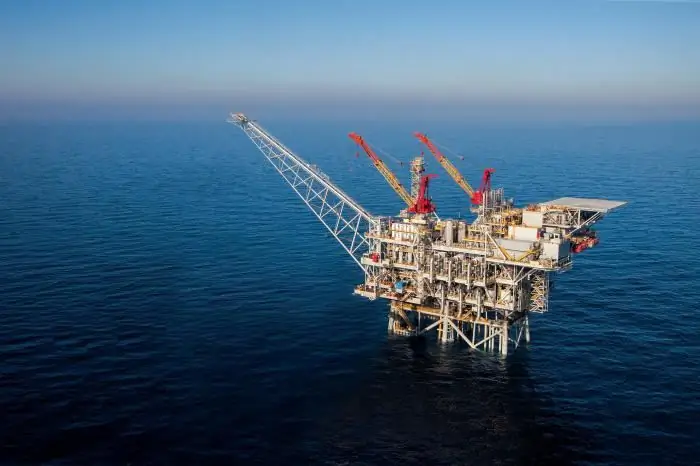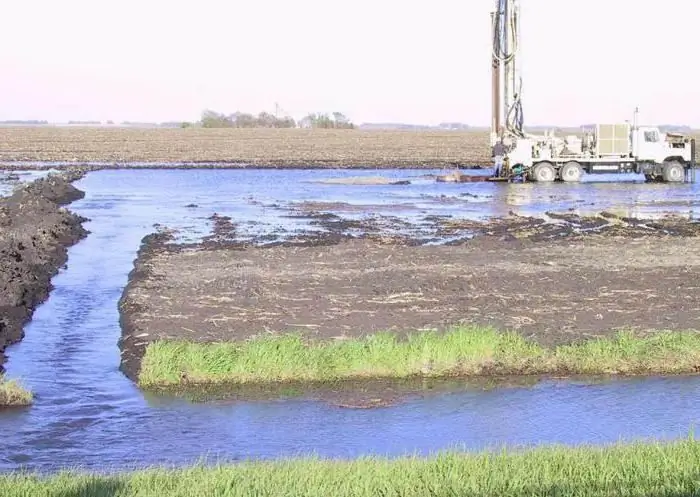2025 Author: Howard Calhoun | [email protected]. Last modified: 2025-06-01 07:12:56
Everyone knows that in order to extract oil it is necessary to drill a well to a considerable depth. This is a complex mining and technical structure, which is not at all like a hole in the rock mass. Hundreds of specialists of various profiles are involved in the construction of the well.
To ensure the durability of the well, its walls are reinforced with steel pipes: a guide, a surface conductor, casing strings.

Symbols: 1 - casing pipes, 2 - cement stone, 3 - reservoir, 4 - perforations.
The production string is run only in wells that are drilled in fields with proven reserves of hydrocarbons and intended for the development of the field. Distinguish wells:
- producing - to extract hydrocarbons to the surface;
- injection - to maintain the pressure in the reservoir at an optimal level;
- estimated - to determine oil or gas reserves;
- observational - to control the regime of the deposit.
Oil Well Construction Project
In order to open a productive oil horizon during drilling, it is necessary to take into account the geological structure of the section, the depth of the oil reservoir, the technology of its opening, the capabilities of the equipment used, the expected complications during drilling and many more geological and technological nuances when designing a well. All this is reflected in the design of the well design.

Well construction stages
It is conditionally possible to distinguish six stages. At the preparatory stage, the exact geographic coordinates of the drilling point are marked, a working site is being prepared, water supply, power supply lines, communications, an access road are being laid, and a rotational camp is being built.
Then, the drilling rig and all drilling equipment are mounted on the prepared site.
The next step is the guiding device, connecting it to the mud cleaning system from cuttings. Test run of the mounted drilling rig.
Followed by drilling, open hole clamping and grouting, opening the productive formation and obtaining an influx of hydrocarbons during the test. In wells that did not give inflow during the test while drilling, the production string is not lowered.

Drilling a well
On the basis of the project, a GTN is compiled - a geological and technical work order (or a daily plan for a drilling crew). All well construction works are carried out in strict accordance with this document. Drilling fluid properties, bit diameter, intervals for coring and geophysical surveys - all well drilling parameters must comply with those specified in the geological and technical order.
Most important for successful penetration to target depth are drilling fluid parameters. It should keep the walls of the well from destruction under the pressure of overlying rocks, not unduly impede drilling, and when opening the productive horizon, prevent the release of hydrocarbons to the surface or flowing.

Fixing an open hole with a string
During drilling, geological formations with different physical properties are exposed, which do not allow further drilling without additional fastening of the well walls:
- weakly cemented rocks that can break under the pressure of circulating drilling fluid;
- reservoirs saturated with water, oil, gas or mixtures thereof, which must be isolated from the open hole.
When opening such intervals, the well is cemented: metal pipes are lowered to the bottom and a mixture of backfill potland cements and various fillers is pumped between the walls of the pipes and the well.
Depending on the design depth and geological structure of the drilling area, additionalintermediate casing strings.
The design of any oil well consists of the following strings: direction, surface conductor, at least one casing and production string.

Completion of construction
After opening the productive formation, testing it and obtaining an inflow of hydrocarbons, drilling is completed by running the production string into the well and plugging it. The main purpose of this column is to lift hydrocarbons to the surface (if it is a production well). Or pumping water into a reservoir under development to maintain reservoir pressure for optimal field development. Therefore, this column is called production.
The depth of the descent of the column depends on the properties of the reservoir from which oil is planned to be extracted. If the reservoir rocks are strongly cemented and stable, the bottomhole zone is not cemented. Filters are installed there, which, in case of clogging, must be replaced. The production string in such cases is lowered to the top of the reservoir.
If the reservoir is composed of loose rocks, oil production with an open bottomhole zone is impossible. The rock particles carried along with it will clog the open part of the shaft, and the influx of hydrocarbons will stop. In this case, the production string is lowered to the bottom and cemented. After the cement hardens, the bottomhole reservoir zone is perforated, restoring communication between the wellbore and the oil-bearing formation.

Column diameter
For oil wells empiricallythe following optimal ratios of string diameters and daily flow rate were established:
- less than 40 m3/day - 114.3 mm;
- 40 to 100m3/day - 127.0-139.7mm;
- 100 to 150m3/day - 139, 7-146, 1mm;
- 150 to 300m3/day - 168, 3-177, 8mm;
- >300m3/day - 177.8-193.7 mm.
The diameter of the production string is set by the customer when designing the well construction and depends on the expected daily oil or gas production rate. It is these parameters that underlie all calculations for drilling, since the calculation of drill bits and casing strings is carried out from the bottom to the wellhead.
Recommended:
Mine well: device, sanitary requirements, value

Description of the construction of shaft wells. What are the requirements for structures during construction and operation. Features of concrete, plastic, wood and brick products. Necessary conditions for the start of construction or restoration. Sanitary standards for the operation of mine wells
"Boat of well-being" in Tolyatti: owner reviews, description

“Boat of well-being” reviews of the owners knowingly deserved almost one positive. The developer chose a very good place for the implementation of his project. The village is located just 20 kilometers from the center of the city of Togliatti, which allows its residents to easily get to work. But at the same time, it guarantees a quiet life away from noisy businesses and the enjoyment of clean air
Modern production. The structure of modern production. Problems of modern production

Developed industry and a high level of the country's economy are key factors influencing the we alth and well-being of its population. Such a state has great economic opportunities and potential. A significant component of the economy of many countries is the production
Gas production. Gas production methods. Gas production in Russia

Natural gas is formed by mixing various gases in the earth's crust. In most cases, the depth of occurrence ranges from several hundred meters to a couple of kilometers. It is worth noting that gas can form at high temperatures and pressures. In this case, there is no access of oxygen to the place. To date, gas production has been implemented in several ways, each of which we will consider in this article. But let's talk about everything in order
Well development: methods, process description, safety. Well repair

The article is devoted to the development of wells. The methods, features and nuances of the implementation of this event, as well as security measures and repair work are considered

